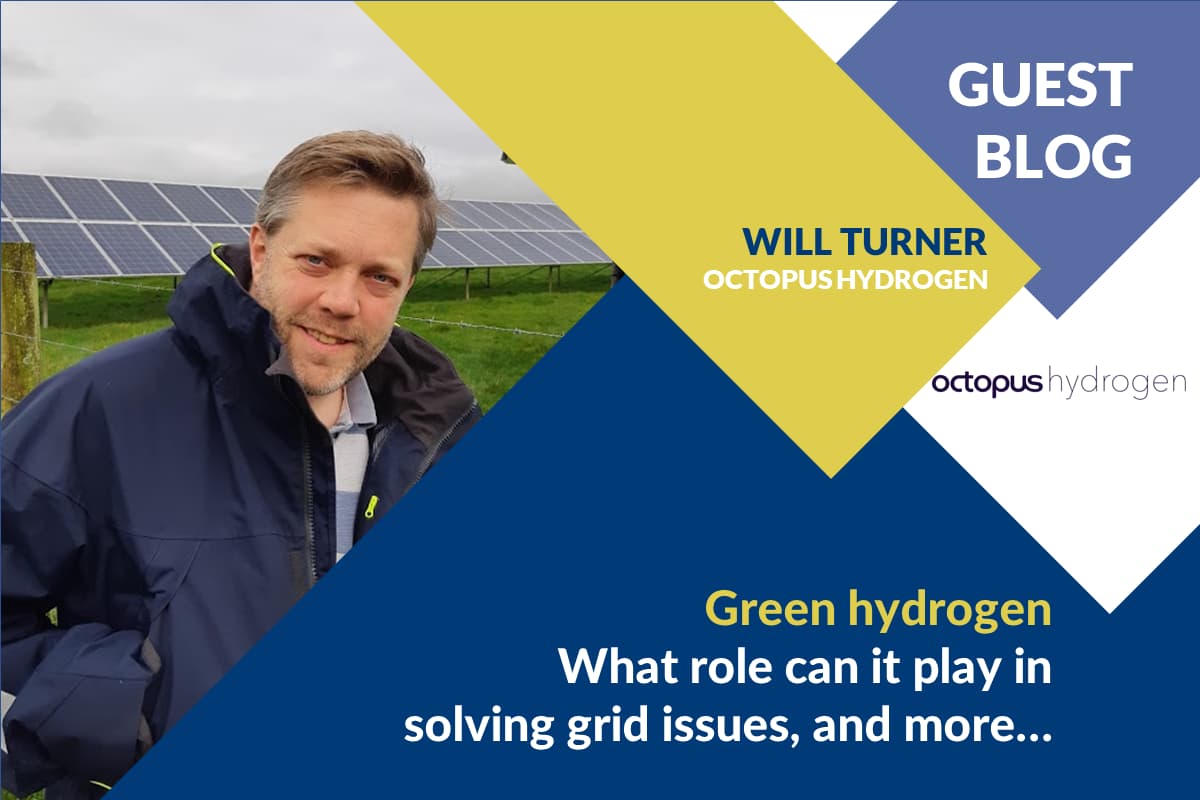Green hydrogen – what role can it play in solving grid issues, and more…
With the potential to unlock additional revenue for renewables projects, and particularly for sites that have network constraints, green hydrogen can be an avenue for developers to explore. In our latest guest blog, Hugh spoke to Will Turner, Head of Commercial & Origination at Octopus Hydrogen to find out more.
Hugh. Can you tell us a bit about Octopus Hydrogen and your role?
Will: Octopus Hydrogen was founded about 18 months ago to provide a decarbonisation solution for hard-to-abate sectors such as heavy transport, shipping, aviation, and industrial gases. We aim to provide the full value chain for green hydrogen, from production, optimisation, logistics and delivery to the end customer. Our business model is for distributed production at renewable sites and managing the production against a portfolio of demand customers. And being an Octopus company, you won’t be surprised to hear that we’re also building the software for remote operation and optimisation of the electrolysers.
My role is split into two areas. Firstly, the origination of new-build renewable sites where we can co-locate electrolysis. This involves talking to many wind and solar developers, discussing site details, and the sorts of things that make a good green hydrogen location. And ultimately taking a selection of sites into detailed Heads of Terms and PPA discussions.
And secondly, I look after the commercial function, responsible for hydrogen sales pricing, production site design and cashflow modelling, and the deep analytics required to make informed decisions.
Hugh: What do we mean by green hydrogen? Why is it important to differentiate?
Will: Green hydrogen is produced by splitting water into hydrogen and oxygen through a process called electrolysis, using electricity from renewable sources. We always prefer to directly co-locate with a renewables site, and draw power from a private wire. The added benefits of being behind-the-meter, such as novel PPA structures, removal of network and policy costs and the usage of curtailed volume typically outweigh the logistics costs of moving the hydrogen to the end customer.
Recent legislative change has made it possible to use grid-sleeved PPAs to achieve the Low Carbon Standard, set by BEIS. So there may be more solely grid connected electrolysis in future.
There are multiple other colours used to describe hydrogen created by other means. The two most prevalent are grey and blue hydrogen. Grey hydrogen is created from natural gas, and so is a fossil fuel. Grey hydrogen is widely used in industrial processes, but with recent increases in wholesale gas prices is becoming expensive to produce. Blue hydrogen doesn’t yet exist, but in theory would be hydrogen created from natural gas complete with carbon capture and sequestration. We currently see green hydrogen out-competing blue on price, and speed of deliverability.
Hugh: What role can green hydrogen play in solving some of the issues with the grid? Can green hydrogen enable more renewables projects?
Will: Green hydrogen has the potential to unlock additional revenue for renewables projects that host an electrolyser, and particularly for those that have network constraints from Active Network Management, or clipped volumes from over-panelling. It’s worth noting that typically an electrolyser’s capacity would be sized at approx. a tenth to a fifth of a solar farm (e.g. 10MW on 60MW DC), and about a third of a wind farm. Any larger and the utilisation of the electrolyser from the renewables drops to make it less viable.
- Clipped volumes: the electrolyser can use volume that would otherwise have been clipped, where the installed capacity of a renewables site is greater than the export capacity, as is common for solar farms.
- Network constraints: an electrolyser isn’t the silver bullet here, as the relative sizing may mean it is unable to use all volume constrained by the Distribution Network Operators. However, it can certainly use a good proportion of it, a great use of volume that would have otherwise been wasted. Ultimately this is a site-specific consideration based on the grid offer, the relative sizing, and the commercial viability of both electrolyser and renewables
- Balancing Mechanism curtailment: another excellent use of otherwise wasted volume. Currently only really available for wind farms, which makes the location more remote than solar.
Electrolysers can also help with grid balancing, as they are flexible load on the system that can turn up/down based on price signals and renewable generation forecasts. The algorithm in our software will schedule the best times to generate hydrogen, based on commercial and operational parameters.
The combination of soaking up renewable power when it’s plentiful, using clipped volumes, and aiding those sites with network constraints, will all enable additional renewable capacity to be built.
Hugh. Are there any challenges or barriers?
Will: There are obviously challenges when establishing a new market. For example, what leads the way in the infamous ‘chicken or egg’ situation of building production vs creating demand. Our approach has been to do both pillars, working with those looking to adopt hydrogen vehicles, as well as identifying and financing the development of multiple production sites.
Grid connections are also very important. For a co-located site to be optimal it really needs an import connection of the 3-5MW scale for a 10MW electrolyser, particularly for solar. This gives flexibility to operate the electrolyser from the grid during low solar periods, in order to meet hydrogen production requirements. In the past, solar farms would often have had minimal grid import, but with the solar+battery model evolving then many developers will look to secure decent grid import.
Electrolysers can co-exist with solar + battery, and although it’s a complicated modelling exercise, the contractual structures are possible to ensure that all assets get a fair share of revenues.
Sticking with grid, the often long lead times for grid connections may push some renewable projects out 3 to 5 years. Our aim is to move swiftly and build multiple 5-20MW electrolyser systems over the next couple of years, so long grid lead times are a challenge to deployment.
Hugh: Tell us a bit about you, why did you choose to move into the green hydrogen sector?
Will: I’ve always had a love of the environment, and renewable energy. I spent ten years at Good Energy, the renewable energy retail supplier, where I was Head of Trading and Portfolio Management. This gave me a great grounding in energy markets, risk management, pricing, PPAs and contractual structures.
I left during lockdown to spend about a year as a contractor across multiple businesses in the energy sector. One of which was Roadnight Taylor! Learning lots about grid connections and batteries from Hugh and his team of Connectologists®, and it’s great to be back working with them again on projects.
In April last year I had an opportunity to join a start-up looking at green hydrogen, and I jumped at the chance to join the nascent Octopus Hydrogen. It’s been a very exciting 18 months, and a steep learning curve.
I also feel very lucky to have several decades worth of energy and trading experience between the three of us in the commercial team. This gives us a particularly strong basis on which to create contracts, analyse opportunities, and manage energy risks in a very volatile environment.
Hugh. What’s coming up for you and Octopus Hydrogen in the next six months?
Will: We will be launching our first project towards the end of this year, the Energy Hub at Mira Technology Park in Nuneaton. This is a 1MW electrolyser with 7MW of solar for green hydrogen production, for the vehicle testing at Mira.
I’ve also got a very exciting large electrolyser project that I’m working on, which will be capable of producing upwards of 4,000kg/day of green hydrogen, enough to fuel 80 long distance HGVs. Can’t say much more at this stage but watch this space!
Contact
For more information on Octopus Hydrogen, please contact Will at will.turner@octohydrogen.com





